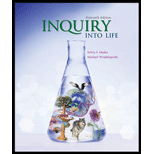
Concept explainers
To write:
Cellular structures that are unique to plant cells.
Introduction
Some cellular structures like a cell wall, plastids, plasmodesmata, vacuole, and glyoxysome are unique to plant cells.
Explanation of Solution
Cell wall
The presence of a cell wall in plant cells distinguishes them from animal cells. It is a non-living structure that is secreted by the cell itself to protect its plasma membrane. Higher plants have cell walls made up of cellulose, hemicellulose, pectin as calcium or magnesium salts, lignin and suberin.
Cell wall consists of three layers, primary cell wall, middle lamella, and secondary cell wall. In flowering plants, primary cell wall show thickening by lignification. Lignin provides greater strength and elasticity to plants.
The cell wall acts as the skeleton in a plant cell. It provides mechanical strength and support to the cell. It also gives a definite shape and rigidity to all plant cells. The cell wall is freely permeable and allows water and substances in solution to enter and leave the cell without any hindrance. It prevents desiccation of the cells.
Plasmodesmata are long tube-like structures of cytoplasm that connect adjacent cells in plants. The cell walls have narrow pores known as pits through which the fine strands of plasmodesmata are able to pass. Intercellular connections of plasmodesmata allow the exchange of materials between the living cell contents.
Plastids are disc or oval-shaped cell organelles present only in plant cells and are absent in animal cells. There are three types of plastids such as chloroplasts, chromoplasts, and leucoplasts.
Chloroplasts are green colored plastids that possess the photosynthetic pigment chlorophyll and are involved in photosynthesis. Each chloroplast is made up of a double membrane envelope and a matrix. The inner membrane is arranged to form a membranous system of lamella and thylakoids. Thylakoids are stacked into structures called grana. Chlorophyll is located within grana. The non-thylakoid, homogenous, proteinaceous part of the matrix is called the stroma. It contains a number of enzymes involved in photosynthesis.
The chloroplasts trap solar energy and use it to manufacture food for the plant through the process of photosynthesis. Solar energy is converted into chemical energy of carbohydrate molecules.
Chromoplasts are plastids with a variety of colors like yellow, orange, purple or red. Chromoplasts provide color to the petals of flowers and fruits. Leucoplast is colorless or white in color and their function is to store food materials in the form of starch, lipids, and proteins.
Vacuoles are fluid-filled sacs like structures surrounded by a single membrane. Vacuoles are present in the cytoplasm of all plant cells. Plant vacuoles are large, permanent and distinct. They contain a variety of substances including carbohydrates, proteins, minerals, sugars, amino acids, pigments and dissolved
Glyoxysomes are single membrane-bound structure found in plants cell. They are found in some seed germinating plant cell and contains enzymes for the glyoxylate cycle.
Cell wall, plasmodesmata, plastids, vacuole, and glyoxysomes are some organelles that are unique to plant cells. Cell wall provides support and mechanical strength of the plants. Plasmodesmata connect adjacent cells in plants. Plastids (Chloroplast) are involved in photosynthesis. Vacuoles stores substances like carbohydrates and proteins. Glyoxysomes contains enzymes for the glyoxylate cycle.
Want to see more full solutions like this?
Chapter 30 Solutions
Inquiry Into Life (16th Edition)
 Human Anatomy & Physiology (11th Edition)BiologyISBN:9780134580999Author:Elaine N. Marieb, Katja N. HoehnPublisher:PEARSON
Human Anatomy & Physiology (11th Edition)BiologyISBN:9780134580999Author:Elaine N. Marieb, Katja N. HoehnPublisher:PEARSON Biology 2eBiologyISBN:9781947172517Author:Matthew Douglas, Jung Choi, Mary Ann ClarkPublisher:OpenStax
Biology 2eBiologyISBN:9781947172517Author:Matthew Douglas, Jung Choi, Mary Ann ClarkPublisher:OpenStax Anatomy & PhysiologyBiologyISBN:9781259398629Author:McKinley, Michael P., O'loughlin, Valerie Dean, Bidle, Theresa StouterPublisher:Mcgraw Hill Education,
Anatomy & PhysiologyBiologyISBN:9781259398629Author:McKinley, Michael P., O'loughlin, Valerie Dean, Bidle, Theresa StouterPublisher:Mcgraw Hill Education, Molecular Biology of the Cell (Sixth Edition)BiologyISBN:9780815344322Author:Bruce Alberts, Alexander D. Johnson, Julian Lewis, David Morgan, Martin Raff, Keith Roberts, Peter WalterPublisher:W. W. Norton & Company
Molecular Biology of the Cell (Sixth Edition)BiologyISBN:9780815344322Author:Bruce Alberts, Alexander D. Johnson, Julian Lewis, David Morgan, Martin Raff, Keith Roberts, Peter WalterPublisher:W. W. Norton & Company Laboratory Manual For Human Anatomy & PhysiologyBiologyISBN:9781260159363Author:Martin, Terry R., Prentice-craver, CynthiaPublisher:McGraw-Hill Publishing Co.
Laboratory Manual For Human Anatomy & PhysiologyBiologyISBN:9781260159363Author:Martin, Terry R., Prentice-craver, CynthiaPublisher:McGraw-Hill Publishing Co. Inquiry Into Life (16th Edition)BiologyISBN:9781260231700Author:Sylvia S. Mader, Michael WindelspechtPublisher:McGraw Hill Education
Inquiry Into Life (16th Edition)BiologyISBN:9781260231700Author:Sylvia S. Mader, Michael WindelspechtPublisher:McGraw Hill Education





